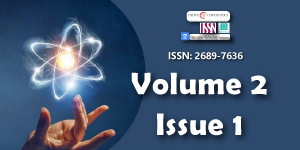Modeling of active thermography through uncertainty quantification of parameters of the heat transfer equation
Main Article Content
Abstract
Active thermography is an experimental technique used to analyze samples of materials or entire structures without destroying them, by means of a heat source, such as a laser beam of a given power. It is posed that such experimental procedure can be modeled mathematically through the complete equation of heat transfer. The uncertainty on the assumption of the value of the parameter emissivity of this equation is to be analyzed calculating the error between concrete experimental data and simulations where such parameter has been taken from the uniform distribution. To the extent of this research, specifically for active thermography, no previous attempt has been made for using at the same time the complete equation of heat transfer (without simplifications or linearizations), with the usage of uncertainty quantification for the specific experimental results to which the mathematical theory was applied.
Downloads
Article Details
Copyright (c) 2019 Tapia AO, et al.

This work is licensed under a Creative Commons Attribution 4.0 International License.
Benzerrouk S (2011) Active and passive thermography for the detection of defects in green-state powdermetallic compacts. (Unpublished doctoral dissertation). Worcester Polytechnic Institute. Link: http://bit.ly/2KqVJDV
Cannas B, Carcangiu S, Concu G, Trulli N (2012) Modeling of active infrared thermography for defect detection in concrete structures. In Proceedings of the 2012 comsol conference. Link: http://bit.ly/2r1OwTQ
Ciampa F, Mahmoodi P, Pinto F, Meo M (2018) Recent advances in active infrared thermography for non-destructive testing of aerospace components. Sensors 18: 609. Link: http://bit.ly/2XpxtY3
Yao Y, Sfarra S, Laguela S, Ibarra-Castanedo C, Wu JY, et al. (2018) Active thermography testing and data analysis for the state of conservation of panel paintings. International Journal of Thermal Sciences 126: 143-151. Link: http://bit.ly/35fBqRV
Borchartt TB, Conci A, Lima R, Resmini R, Sanchez A (2013) Breast thermography from an image processing viewpoint: A survey. Signal Processing 93: 2785-2803. Link: http://bit.ly/2OhvmkU
Marin E (2009) Linear relationships in heat transfer. Lat Am J Phys Educ 3. Link: http://bit.ly/2qYaEyD
Valiente H, Delgado-Vasallo O, Abdelarrague R, Calderon A, Marin E (2006) Specific heat measurements by a thermal relaxation method: Influence of convection and conduction. International journal of thermophysics 27: 1859–1872. Link: http://bit.ly/2OfyugY
Marin E, Delgado-Vasallo O, Valiente H (2003) A temperature relaxation method for the measurement of the specific heat of solids at room temperature in student laboratories. American Journal of Physics 71: 1032–1036. Link: http://bit.ly/2CRt0nF
Lopez-Falcon D, Diaz-Viera M, Herrera I, Rodriguez-Jauregui E (2008) Systematic formulation of continuum systems: Theoretical modeling of combustion fronts in porous media. Numerical Modeling of Coupled Phenomena in Science and Engineering. Link: http://bit.ly/2Qtv6Sp
Diaz-Viera MA, Ortiz-Tapia A, Hernandez-Perez JR, Castorena-Cortes G, Roldan-Carrillo T, et al. (2019) A flow and transport model for simulation of microbial enhanced oil recovery processes at core scale and laboratory conditions. International Journal of Numerical Analysis and Modeling 16: 63-96. Link: http://bit.ly/33SWhKm
Sullivan TJ (2015) Introduction to uncertainty quantification. 63. Link: http://bit.ly/2OnpC97
ISO I, OIML B (1995) Guide to the expression of uncertainty in measurement. Geneva Switzerland.
Sewell G (2005) The numerical solution of ordinary and partial differential equations. John Wiley and Sons 75. Link: http://bit.ly/2CYBFEx
Simpson M, Clement T (2003) Comparison of finite difference and finite element solutions to the variably saturated flow equation. Journal of hydrology 270: 49-64. Link: http://bit.ly/33WCB8B
Raviart PA, Thomas JM (1977) A mixed finite element method for 2-nd order elliptic problems. Mathematical aspects of finite element methods 292–315. Link: http://bit.ly/2Qukh2K
Zienkiewicz OC, Taylor RL, Zienkiewicz OC, Taylor RL (1977) The finite element method. McGraw-hill London.
COMSOL Multiphysics (2008) User’s guide. version 3.5 a. COMSOLAB.
Alnæs MS, Blechta J, Hake J, Johansson A, Kehlet B, et al. (2015) The fenics project version 1.5. Archive of Numerical Software 3. Link: http://bit.ly/2XkN9fc
Dıaz-Viera MA, Ortiz-Tapia A (2018) Lecture notes in mathematical, numerical and computational modeling of flow and transport in porous media. UNAM Posgrado de Ciencias de la Tierra.
Bergman TL, Incropera FP, Lavine AS, Dewitt DP (2011) Introduction to heat transfer. John Wiley and Sons. Link: http://bit.ly/2r3j9Iq

